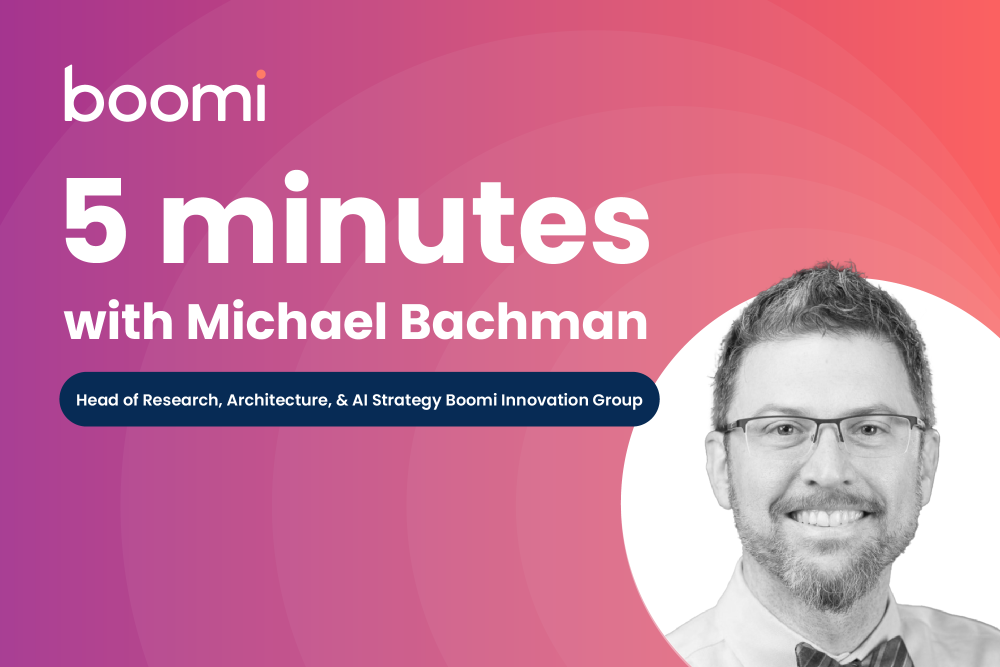Ask Michael Bachman what he likes most about his job, and he has three quick answers:
- People
- Process (how things work)
- Technology
“I’m intensely curious about how tech can help people,” said Bachman, global architect and head of the Office of the CTO at Boomi. “People are an endless engine of inspiration. I’m interested in understanding the ideas that get them excited. Then I derive the most joy from helping them arrive at ‘a-ha moments’ where tech is the enabler of achieving those outcomes.”
That’s why Bachman is at ease managing a team that concentrates on emerging technologies, finding solutions around global challenges such as sustainability and showing organizations across all industries how they can improve lives through better connectivity and automation.
Curiosity is at the heart of what they do. The team explores how processes work – or don’t – for businesses and how better use of technology tools can improve efficiency.
“We’re at the intersection of the art of the possible and the reality of feasible,” Bachman said. “That’s where the magic happens. We’re focused on next-generation thinking about what’s coming down the road in the three, five, 10 years, and help our customers be ready for that now.”
We asked Bachman to share his thoughts on (among other things) technology, connectivity, and the story behind his trademark bow ties.
Our most important question first. Give us your favorite pizza-toppings combination and why that integration works for you.
Bachman: I’d say jalapenos and cheese. I’m aspiring to be vegetarian. I like spice. A lot. So, anything like red peppers, jalapenos, any hot peppers whatsoever, I really like those. And I love putting them on cheese pizza.
How would you explain to your grandmother what Boomi does and your role?
Bachman: The analogy I would use for her, specifically, is that Boomi is like a switchboard operator making connections between two different callers. And instead of people, the “callers” are these new software applications. My role is to think about how to make Boomi’s position as the operator more efficient so we can connect the entire world.
How do you explain Boomi’s value proposition to business leaders?
Bachman: Boomi makes data useful. We discover data and then make sure it’s properly cataloged and synchronized across different applications throughout the organization. That prepares integration and intelligent data services pipelines as the foundation of automating and optimizing data. Businesses need to thoroughly know and trust their data. Customers use Boomi to optimize their data flows, know how to connect their data, and then make it available through a variety of resources.
Why is it so hard for businesses today to realize a connected digital architecture?
Bachman: More and more data is being generated and processed on more best-of-breed applications. That can create massive headaches. Lots of different systems need to talk to each other. There’s also a hyper-focus on making sure data is secure, trusted, valid, accurate, and up-to-date. Those are difficult today, especially when we’re bringing in different data sources. How do you marry all of that together? You need a pragmatic way to take advantage of your data.
Did you have your own “a-ha moment” about the growing need for business integration?
Bachman: It happened organically. In business, we think about use cases. But it clicked in my mind that a better way for me to think about the bigger picture was in patterns. Integration is very much at the heart of that. The fundamental way applications work is input, transformation, and output. When you think of it like that, you can make even very complex architecture simple to understand. That simplicity is reliant upon proper integration. Without integration, you can’t go from use case to pattern.
One could see integration as more than connecting software and having broader societal implications.
Bachman: I view it in layers of abstraction. We’re connecting humans in a way that invokes feeling through the use of technology. Some would argue that technology disconnects us from society, and I’m definitely sensitive to that point. We can come up with plenty of examples, including everybody looking at their cell phone at dinner time and not looking at each other. Technology can become a disconnector. But think about how technology exposes us to different worlds. My daughter now has friends with kids her own age all around the planet. If you or I were to tell our younger selves that we would regularly talk to each other across thousands of miles through video communication, we would have thought, “no way.” But in a way, we’re living in sci-fi right now. That’s the power of technology enabling connectivity.”
Few of us have a straight line in our career trajectory. What journey led you to where you are?
Bachman: I was a [computer] nerd growing up – at least that’s what many schoolmates called me. For the record, I played baseball, too. I got away from computers and math later in high school to explore other areas like language and culture and pursued a liberal arts degree. When I completed coursework for my International Affairs and German Studies majors, I latched onto computer science courses – and I loved it.
Having a non-technical undergraduate degree has served me well. The ability to synthesize world events, speak other languages to connect with different cultures, and think on a global scale all laid the foundation for me to be a pattern-based thinker and a creative technologist. After college, I had a couple of sales jobs. I wasn’t particularly good. But I was good at problem-solving with technology. I understood processes, problems, and the personas that needed help. Eventually, I discovered there was a role called “Pre-Sales Engineer.” Once I became an SE, there was no looking back.
Before you go, we need to ask: What’s with the bow ties?
Bachman: I wear bow ties to invoke the legacy of my great-grandfather, who was a haberdasher. He wore bow ties every day. I’ve accumulated a collection of over 70, and I wear them all. They’re good conversation pieces. I’ve found that few know how to tie them. Sometimes I give a quick tutorial to folks who are curious to learn — it’s a way to bring the human element into conversations that often can be technical.
Up Close With Michael Bachman
 Role: Principal Global Architect & Head, Boomi Office of the CTO
Role: Principal Global Architect & Head, Boomi Office of the CTO
Home: Greater Philadelphia area
Family: Children Alexandra (17) and Andrew (15).
Education: Dual bachelor’s degrees in International Affairs and German Studies, Lewis & Clark College. Coursework toward Masters Computer and Information Technology, University of Pennsylvania
Career: Previously a principal architect and senior technologist at Dell Technologies.
Cool Facts: Co-author of “Modern Enterprise Data Pipelines.” Helped name the OV-105 Space Shuttle (Endeavor).

 English
English 日本語
日本語